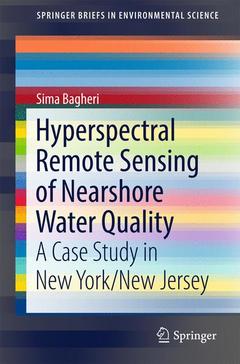Description
Hyperspectral Remote Sensing of Nearshore Water Quality, 1st ed. 2017
A Case Study in New York/New Jersey
SpringerBriefs in Environmental Science Series
Language: English
Subjects for Hyperspectral Remote Sensing of Nearshore Water Quality:
Publication date: 11-2016
Support: Print on demand
Support: Print on demand
Description
/li>Contents
/li>Biography
/li>Comment
/li>
This book provides details on of the utility of hyperspectral remote sensing ? NASA/AVIRIS in nearshore water quality issues of NY/NJ. It demonstrates the use of bio optical modeling and retrieval techniques to derive the concentrations of important water quality parameters (chlorophyll, color dissolved organic matter and suspended sediments) in the study area. The case study focuses on the nearshore waters of NY/NJ considered as a valued ecological, economic and recreational resource within the New York metropolitan area. During field campaigns (1998-2001) measurements were made to establish hydrological optical properties of the NY/NJ nearshore waters with concurrent NASA/AVIRIS overflights. The field measurements included: 1) concurrent above and below surface spectral reflectance; 2) shipboard sampling for determination of inherent optical properties (IOP); and 3) concentrations of optically important water quality parameters. Understanding the relationship between reflectance, absorption and scattering is essential for developing the analytical algorithm necessary to use remote sensing as a monitoring /management tool in the nearshore environment.
1. Introduction.- 2. New York/New Jersey Nearshore waters – A Case Study.- 3.- In-situ measurements to Establish the Biooptical Model.- 4. Application of Hyperspectral Data.- 5.- Forward/Biooptical Modeling and Calibration.- 6.- Inverse Modeling and Validation.- 7.- Conclusion and Role of Hyperspectral Data in Global Change Research.
Sima Bagheri is professor of civil and environmental engineering at University Heights, New Jersey Institute of Technology, with research focus on establishing remote sensing as an operational management tool in assessing the quality of New Jersey's nearshore waters. She has been recommended as an author and editor by Prof. Klemas, Marine Studies, University of Delaware, and SWS member. He also reviewed her proposal.
To provide concise guidelines in remote sensing data analysis, in situ measurements and modelling to help managers and planners in coastal water quality investigation Information on the role of phytoplankton in the exchange of carbon dioxide between ocean and atmosphere is important since algae have the potential both as an energy source and a way to deal with global warming The relationship between remote sensing data and field measurements at the local scale can be linked to global scale processes to assess the impacts of climate change on fresh/coastal waters of NY/NJ metropolitan area Includes supplementary material: sn.pub/extras
© 2024 LAVOISIER S.A.S.




